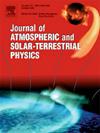太阳活动低时赤道站总电子含量:地磁活动影响重点
IF 1.8
4区 地球科学
Q3 GEOCHEMISTRY & GEOPHYSICS
Journal of Atmospheric and Solar-Terrestrial Physics
Pub Date : 2025-02-01
DOI:10.1016/j.jastp.2024.106415
引用次数: 0
摘要
本文给出了塔拉瓦赤道站(地理位置:1.33°N, 173.01°E,地磁位置:2.68°S, 114.26°W) 2017年9月至2018年11月总电子含量(TEC)数据的初步结果,结果表明,在15:00-14:00之间,总电子含量(TEC)达到日最大值。磁场扰动日的VTEC高于无扰动日。7次地磁风暴(5次中、2次强)的VTEC响应均表现为电离层正效应。给出了2017年11月7-8日(中等强度,Dst =−72 nT)和2018年8月25-26日(强烈强度,Dst指数=−174 nT)两次地磁风暴的VTEC响应。在11月风暴期间,TEC在主相第一步发展期间减少了约25.6%,在主相第二阶段发展期间增加了约26.2%。在8月风暴主阶段,VTEC持续时间较长(24 h),增幅约为47.3%。两场风暴主阶段的VTEC变化都是由于风暴时的极光提示穿透电场,而扰动发电机电场在恢复阶段产生了负电离层效应,这可以从SWARM A、B和C卫星的赤道电喷数值变化和AE指数中分别看出。TIMED卫星上的全球紫外成像仪(GUVI)的全球O/N2气体数据表明,O/N2的变化在较小程度上也是我们站观测到的地磁风暴效应的原因。本文章由计算机程序翻译,如有差异,请以英文原文为准。
Total electron content at an equatorial station during low solar activity: Geomagnetic activity effects emphasis
The initial results of Total Electron Content (TEC) data from September 2017 to November 2018 recorded over an equatorial station, Tarawa (geographic: 1.33°N, 173.01°E, geomagnetic: 2.68°S, 114.26°W) are presented which showed diurnal TEC maxima between 15:00–14:00 LT. The seasonal and semi-annual variations in the VTEC are clear, along with the less occurring winter anomalies and TEC bite-outs. The VTEC on magnetically disturbed days was higher than on quiet days. VTEC response to seven geomagnetic storms (5 moderate and 2 intense) showed positive ionospheric effect by all storms during their main phase. The VTEC response to two selected geomagnetic storms of 7–8 November 2017 (moderate strength, Dst = −72 nT) and 25–26 August 2018 (intense strength, Dst index = −174 nT) has been presented. During the November storm, TEC decreased by about 25.6% during the first step development of the main phase and increased by approximately 26.2% during the second step of main phase development. A long duration (>24 h) increase in VTEC of about 47.3% was found during the main phase of the August storm. VTEC changes during the main phase of both storms are due to the storm-time auroral prompt penetrating electric field, while the disturbance dynamo electric field produced negative ionospheric effects during their recovery phases as indicated by changes in equatorial electrojet values obtained from SWARM A, B, and C satellites and AE index, respectively. The global O/N2 gas data from the Global Ultraviolet Imager (GUVI) onboard TIMED spacecraft show that O/N2 changes, to a lesser extent, were also responsible for the geomagnetic storm effects observed at our station.
求助全文
通过发布文献求助,成功后即可免费获取论文全文。
去求助
来源期刊

Journal of Atmospheric and Solar-Terrestrial Physics
地学-地球化学与地球物理
CiteScore
4.10
自引率
5.30%
发文量
95
审稿时长
6 months
期刊介绍:
The Journal of Atmospheric and Solar-Terrestrial Physics (JASTP) is an international journal concerned with the inter-disciplinary science of the Earth''s atmospheric and space environment, especially the highly varied and highly variable physical phenomena that occur in this natural laboratory and the processes that couple them.
The journal covers the physical processes operating in the troposphere, stratosphere, mesosphere, thermosphere, ionosphere, magnetosphere, the Sun, interplanetary medium, and heliosphere. Phenomena occurring in other "spheres", solar influences on climate, and supporting laboratory measurements are also considered. The journal deals especially with the coupling between the different regions.
Solar flares, coronal mass ejections, and other energetic events on the Sun create interesting and important perturbations in the near-Earth space environment. The physics of such "space weather" is central to the Journal of Atmospheric and Solar-Terrestrial Physics and the journal welcomes papers that lead in the direction of a predictive understanding of the coupled system. Regarding the upper atmosphere, the subjects of aeronomy, geomagnetism and geoelectricity, auroral phenomena, radio wave propagation, and plasma instabilities, are examples within the broad field of solar-terrestrial physics which emphasise the energy exchange between the solar wind, the magnetospheric and ionospheric plasmas, and the neutral gas. In the lower atmosphere, topics covered range from mesoscale to global scale dynamics, to atmospheric electricity, lightning and its effects, and to anthropogenic changes.
 求助内容:
求助内容: 应助结果提醒方式:
应助结果提醒方式:


